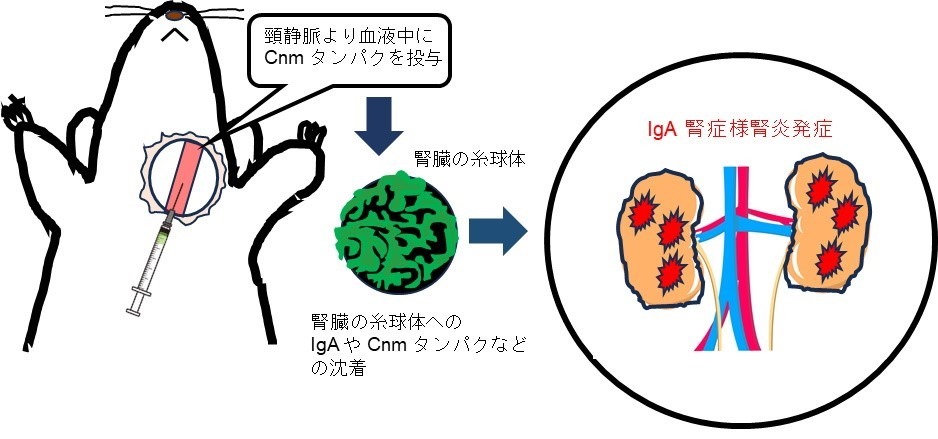Achievements
It has been revealed that the surface protein of dental caries bacteria may be involved in the onset of the designated intractable disease IgA nephropathy! ~ Aiming to establish a fundamental treatment method through medical and dental collaboration ~
A collaborative research group including Professor Nakano Michiyo, Associate Professor Naka Shuhei, Department of Pediatric Dentistry, Okayama University Graduate School of Medicine, Dentistry and Pharmaceutical Sciences (Dental), Professor Nakano Kazuhiko, Department of Pediatric Dentistry, Osaka University Graduate School of Dentistry, Misaki Taro, Director of the Department of Nephrology, Hyogo Medical University Hospital, Associate Professor Nagasawa Yasuyuki, Department of General Internal Medicine, Hyogo College of Medicine Hospital, and Professor Nomura Ryota, Department of Pediatric Dentistry, Hiroshima University Graduate School of Medical and Health Sciences, has revealed in an animal model study that one of the proteins produced on the surface of the cavity-causing bacteria (mutans streptococcus) may be involved in the onset mechanism of IgA nephropathy, a designated intractable disease with an unknown cause and no established fundamental treatment.
Epidemiological surveys in Japan estimate that there are approximately 33,000 patients with IgA nephropathy across a wide age range, from children to adults, and the disease has been considered one of the diseases for which there is no fundamental cure. However, now that part of the disease's onset mechanism has been clarified, it is hoped that this will lead to the establishment of a fundamental cure.
The results of this research were published in the British scientific journal Communications Biology on September 14th.
Key points of this study
●Until now, the details of the mechanism behind the development of IgA nephropathy, a designated intractable disease, have not been elucidated.
It has been shown that collagen-binding protein, one of the proteins present on the surface of dental caries bacteria, may be related to the onset of IgA nephropathy.
●It is believed that further research through collaboration between medical and dental departments may lead to the development of a fundamental treatment for IgA nephropathy.
Overview
IgA nephropathy is a disease in which the immunoglobulin protein IgA is deposited in the glomeruli of the kidney. In many cases, the condition progresses chronically, and if it progresses to end-stage renal failure, treatments such as dialysis or kidney transplants are required. Until now, it has been thought that some kind of "infection" may be involved, but the details have not been clarified. In particular, since this disease can be triggered by upper respiratory tract infections and tonsillitis, it has been hypothesized that it may be related to oral bacteria, but little research has been conducted in collaboration with medical and dental institutions.
We succeeded in inducing IgA nephropathy-like nephritis in rats by injecting caries-causing bacteria (Streptococcus mutans) isolated from the saliva of patients suffering from IgA nephropathy into the jugular vein. We also discovered that the surface of the bacteria isolated from the patient contained a protein called Cnm that binds to collagen, which is not present in many normal caries-causing bacteria, and we came to the hypothesis that this Cnm protein itself may be involved in part of the mechanism of IgA nephropathy onset.
Research Results
Previously, when caries-causing bacteria with Cnm protein on its surface were administered to rats via the jugular vein, it was possible to reproduce the onset of nephritis similar to IgA nephropathy that occurs in patients. In this study, we artificially created the Cnm protein on the surface of the bacteria and administered it to rats via the jugular vein in the same way, and found that nephritis developed simply through the administration of the Cnm protein. This suggests that if caries-causing bacteria with Cnm protein are present in the mouth, then for some reason the bacteria may enter the body and induce nephritis similar to IgA nephropathy.

Social significance
This research has demonstrated the possibility that a specific surface protein of dental caries bacteria may be involved in the onset mechanism of IgA nephropathy, for which no fundamental treatment has been established to date. In the future, we hope that by considering ways to control the disease caused by this protein, we will be able to create a favorable situation in which new treatments can be established. In addition, since it is expected that reducing dental caries bacteria through an approach in the dental field may improve the condition of patients' kidneys, we believe that it is important to strengthen medical and dental cooperation, especially when it comes to IgA nephropathy.
Publication information
Paper title
Contribution of collagen-binding protein Cnm of Streptococcus mutans to induced IgA nephropathy-like nephritis in rats
Publication
Communications Biology
Author of the paper
Shuhei Naka, Daiki Matsuoka, Taro Misaki, Yasuyuki Nagasawa, Seigo Ito, Ryota Nomura, Kazuhiko Nakano, Michiyo Matsumoto-Nakano
DOI
10.1038/s42003-024-06826-x
URL
https://doi.org/10.1038/s42003-024-06826-x
Source of research funds
This research was supported by the Japan Society for the Promotion of Science (JSPS) Grants-in-Aid for Scientific Research (Grant-in-Aid C・23K09435, Principal Investigator: Naka Shuhei), (Grant-in-Aid B・23K27805, Principal Investigator: Nakano Michiyo), (Grant-in-Aid B・24K02650, Principal Investigator: Nakano Kazuhiko), (Grant-in-Aid C・23K09146, Principal Investigator: Misaki Taro).